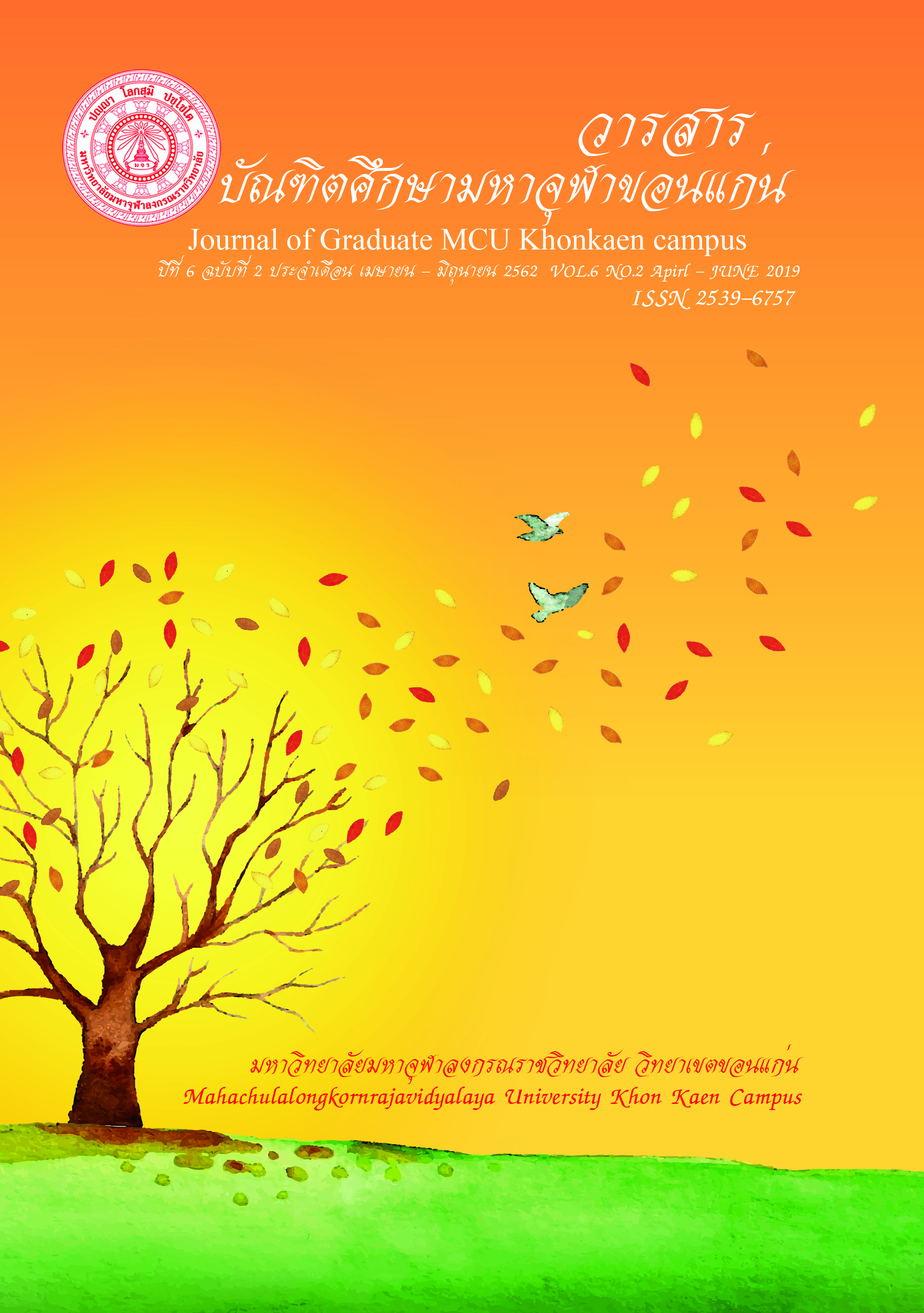A Study of Cultural Relation between Sema Stones and Buddhist Community Lifestyle in Chaiyaphum
Main Article Content
Abstract
The aims of this research were: 1) to study the origin and development of the culture of Sema stones in Buddhism; 2) to study the lifestyle in Buddhist community in Chaiyaphum province; 3) to study the cultural relation between the Sema stones and the community lifestyle of Buddhists in Chaiyaphum province. This qualitative research was conducted by collecting the data by means of the participatory observation and the structured in-depth interview of the samples within the studied area before the obtained data were presented by the descriptive analysis.
The research results revealed that the Sema stones were created from the Buddhist provisions in the discipline (vinaya) of using the stone sheet as the boundary markers of the Uposatha. It is influenced by the art from the Pala-Sen periods of India, combined with the concept of embroidery of the stone carved in the shape of Sema Dharma Wheel in the reign of Ashoka the Great by bringing the stories in Buddhism to be created and presented as a carving picture combined with the invention of various patterns. Then, it was developed as a unique stone leaf shape in Dvaravati, Sukhothai, Ayutthaya and Rattanakosin kingdoms. There is also a combination of improvement in both Mon culture and Khmer culture and it eventually becomes evidence that recorded the history, art, dress, language, literature, traditions and civilization of Theravada Buddhism in the community.
Lifestyle of Chaiyaphum people has been seen as a farming and hunting community with peace and simplicity. Most people in the community respect Buddhism and believe in ghosts. There is a culture that blends with the Buddhist practices that come with Indian culture, Dvaravati culture in a central region, Khmer culture in the capital city and Lao culture combined with the local traditional ritual traditions, resulting in rituals and traditions, namely Phee Fa Dance, Hea-nak, Krathup Ceremony, Relics Bathing Ceremony, Stupa Bathing Ceremony, Sema Stone Bathing Ceremony, HeaKapkeawBuakhaimalai King Muaeng Kalong Ceremony, PrayaiDvaravati Bathing Ceremony, Celebration of ChophoPhaya Lea, Boon DuenHokNongPlathoa. These ceremonies have been practiced until today.
The relationship between the community life and Sema stones in Chaiyaphum province is related to Buddhist culture, beliefs, faith, arts, traditions, rituals, languages, letters, literature and dress. It is a close relationship at the level of kinship and mutual influences, causing the people in the community to change the culture which is derived from the research of knowledge from the Sema stone to use in living under the belief in the same culture.
Article Details
References
Bangkok: Art and Culture Printing.
Charat Phayakkharatsak. (1991). Isan 1 Satsana Lae Wannakam Niyom Nai
Thongthin. Bangkok: O S Pinting House.
HRH Princess Maha Chakri Sirindhorn. (1981). Ten Glory in Theravada
Buddhism. Thesis Master of Arts, Graduate School: Chulalongkorn
University.
Mahachulalongkornrajavidyalaya University. (1996). Thai Tripitaka : Thai
Version. Bangkok: Mahachulalongkornrajavidyalaya Press.
Nanthawan Laolitthi. (2012). Chaiyaphum in the Past. Nonthaburi: S.P.V.
Princess.
Office of Natural Resources and Environmental Policy and Planning of
Chaiyaphum Provincial Nature Conservation and Art Center Satree
Chaiyaphum School. (2005). A Study Report to Declare Nature and
Arts Conservation Area. Chaiyaphum: Satrichaiyaphum School.
Philosophy
Ethic Arts
Culture
Enlighten
ment
Padisorn Phensud. (MR.p.). (2009). Analysis of engravings of
Widhurabunditta on Dvaravati Dummy part of E-San. Bangkok:
Damrong academic Printing.
Somkiet Lophetcharattana. (2013). Lopburi Art and Davaravati Art in
Thailand. Bangkok: Ammarin Printing and Publishing.
Srisak Wanliphodom. (1997). The Kingdom of Thailand in the Five Decades
of Reign. Bangkok: Division of Literature and Literature History
Fine Arts Department.
Sukanya Baonid. (2002). Archaeological excavation year of 2002
Archaeological sites at Muengbua Village. Muengbua Sub-District
Kasetwisai District Roi-Ed Province. Ubonratchathani: Office of
Archaeological and National Museum 8 Ubonratchathani.
Suwilai Premsrirattana et al., (2006). Yorhkura Mon ancient in Thephsathit.
Bangkok: O.S.Printing house Ltd.
Thida Saraya. (1989). (Sri) Dvaravati: Early history of Siam. Bangkok:
Muengboran Princess.
Udom Buasri. (1991). History and prosperity of Buddhism in the Northeastern
in E-San period of Buddhism. Khonkaen: Khonkaen University.
Wiroth Srisuro. (1993).Folk Culture: Fine Arts. (2
nd ed.).Bangkok:
Chulalongkorn University Princess.

